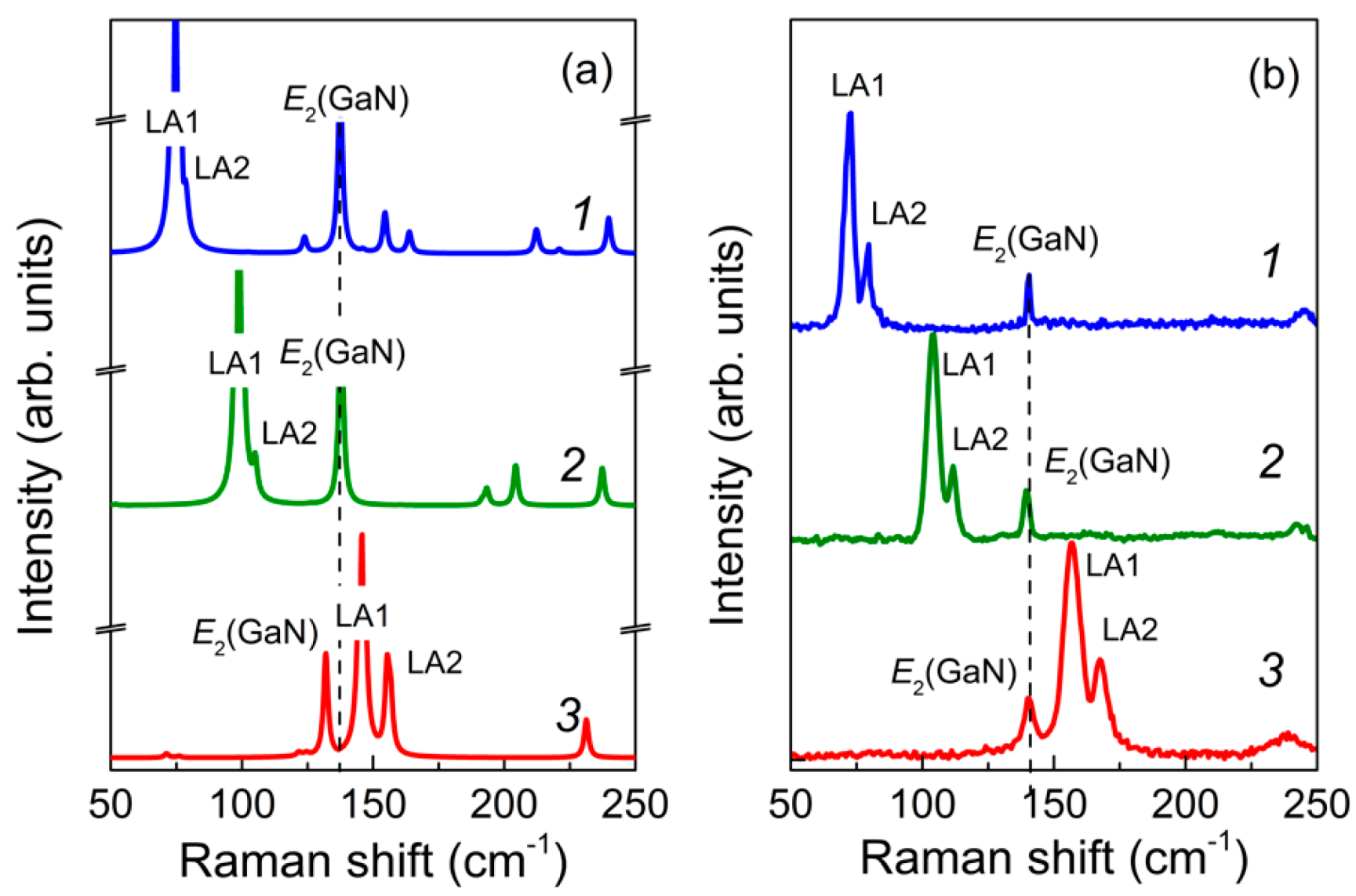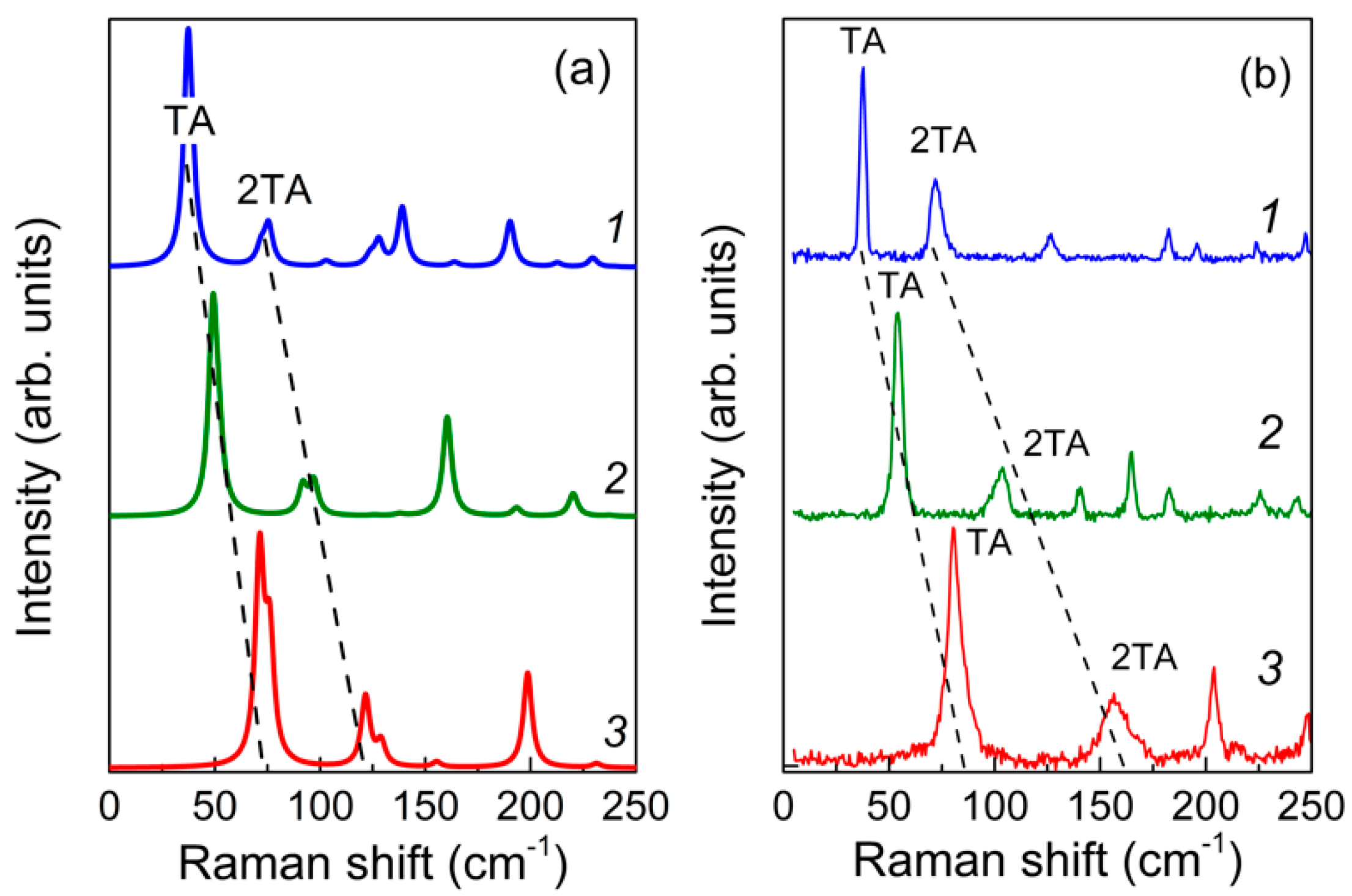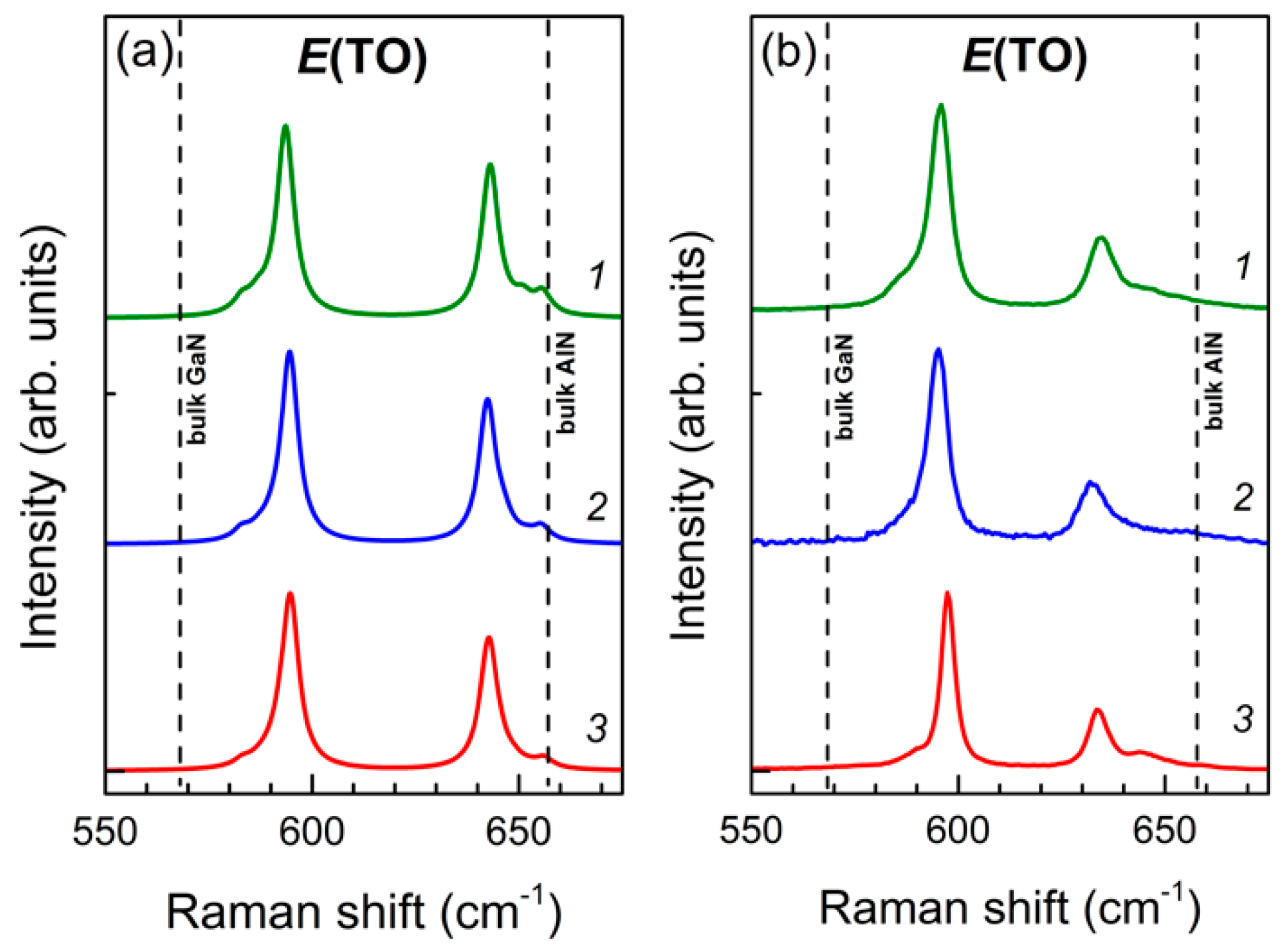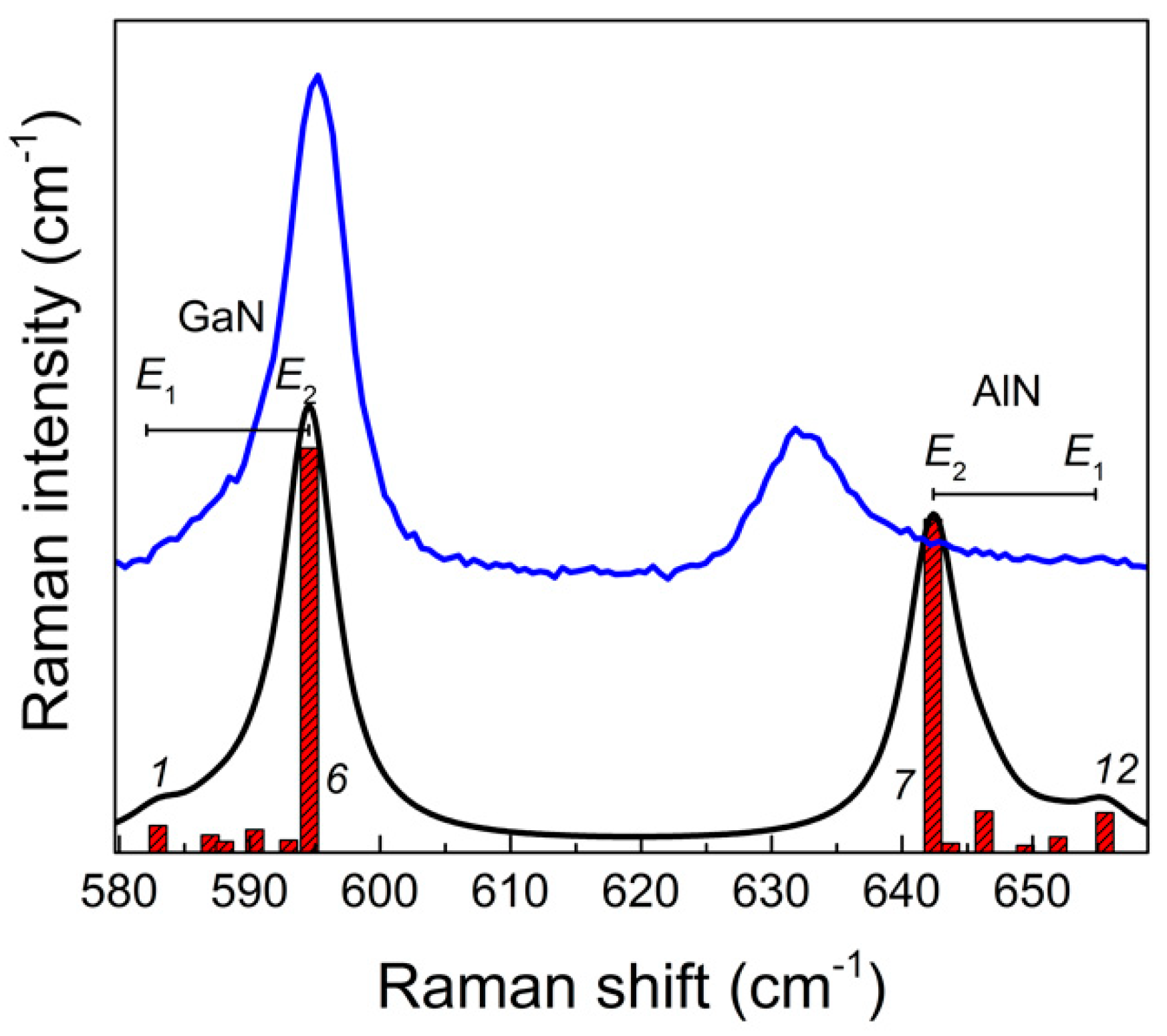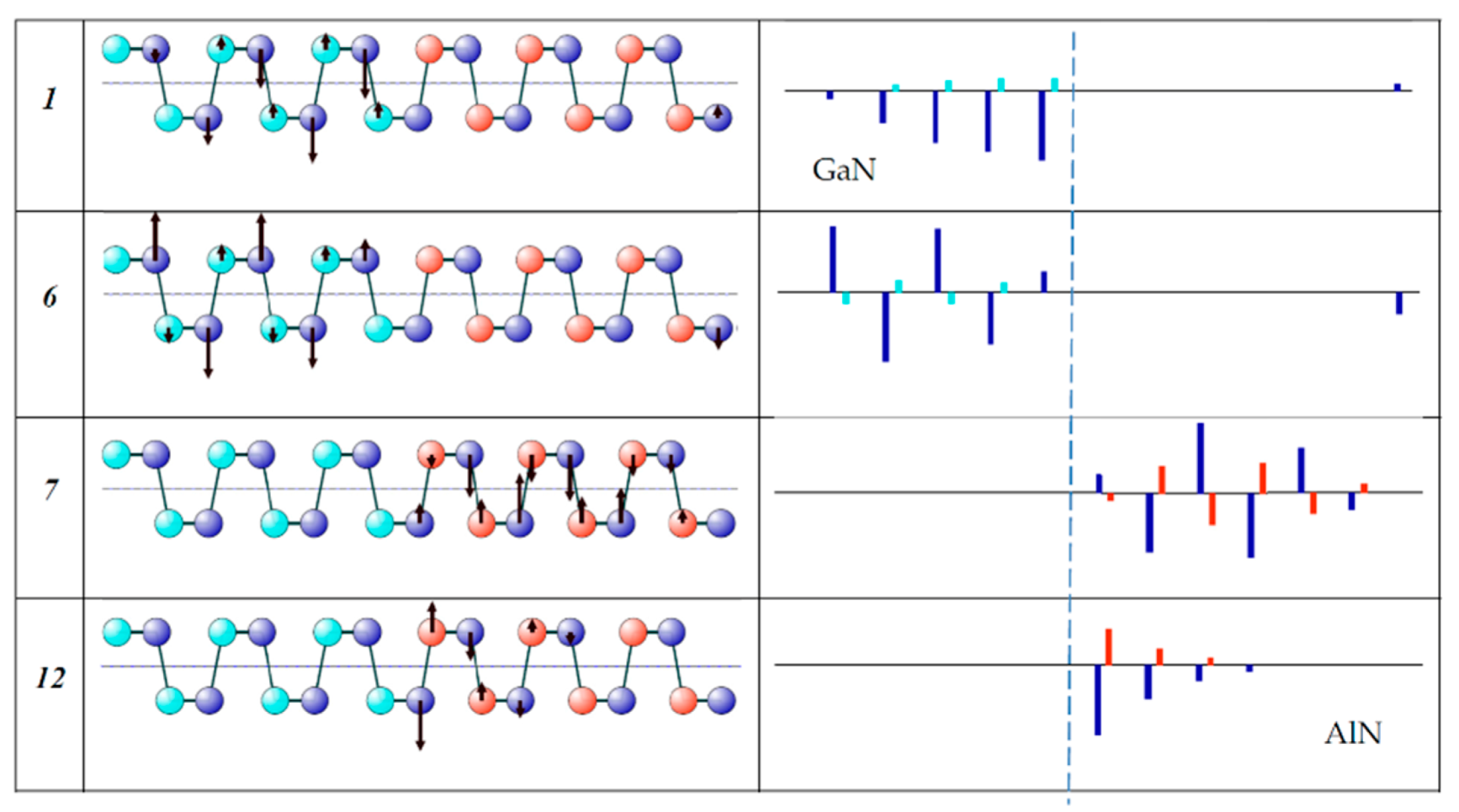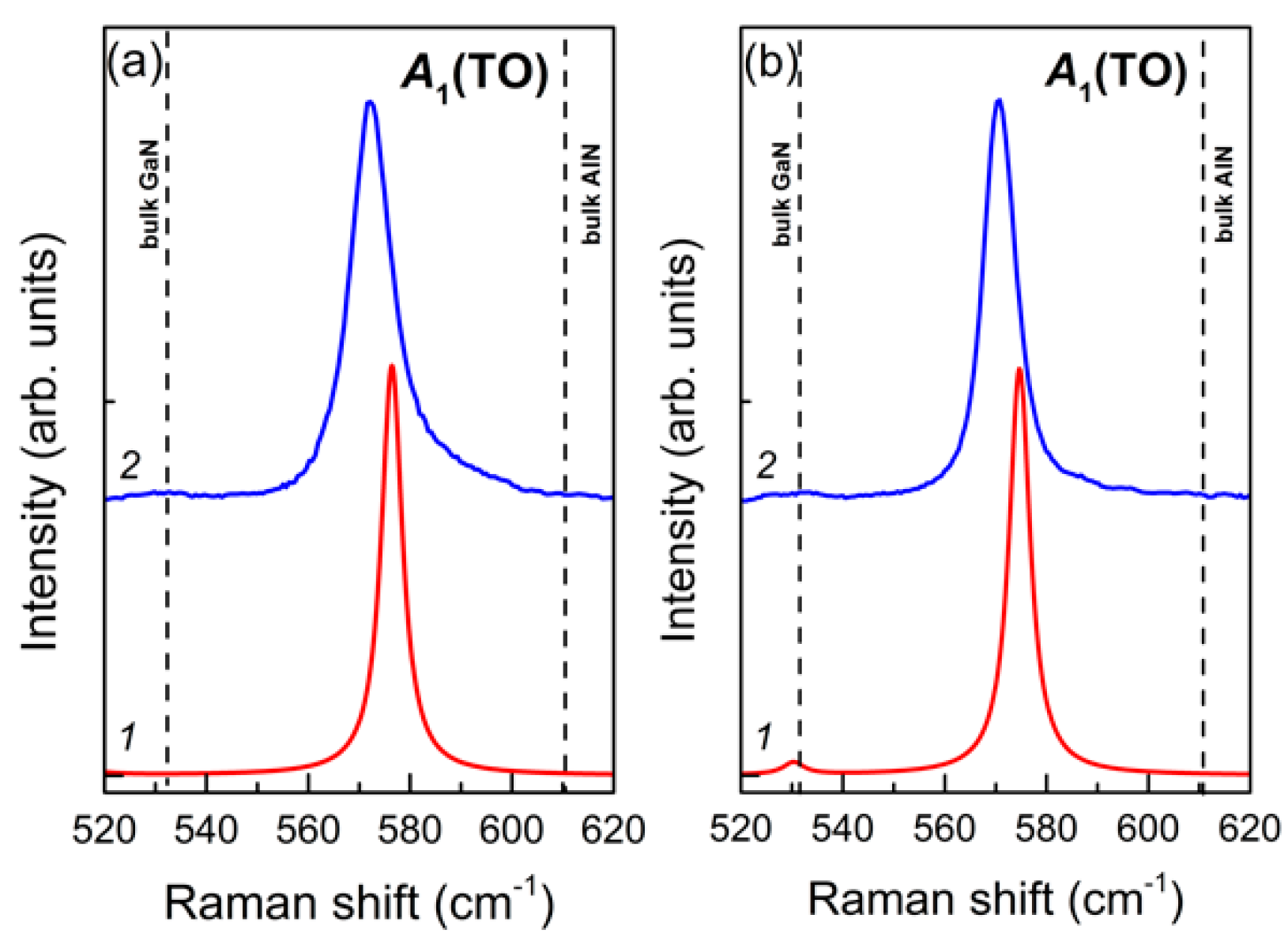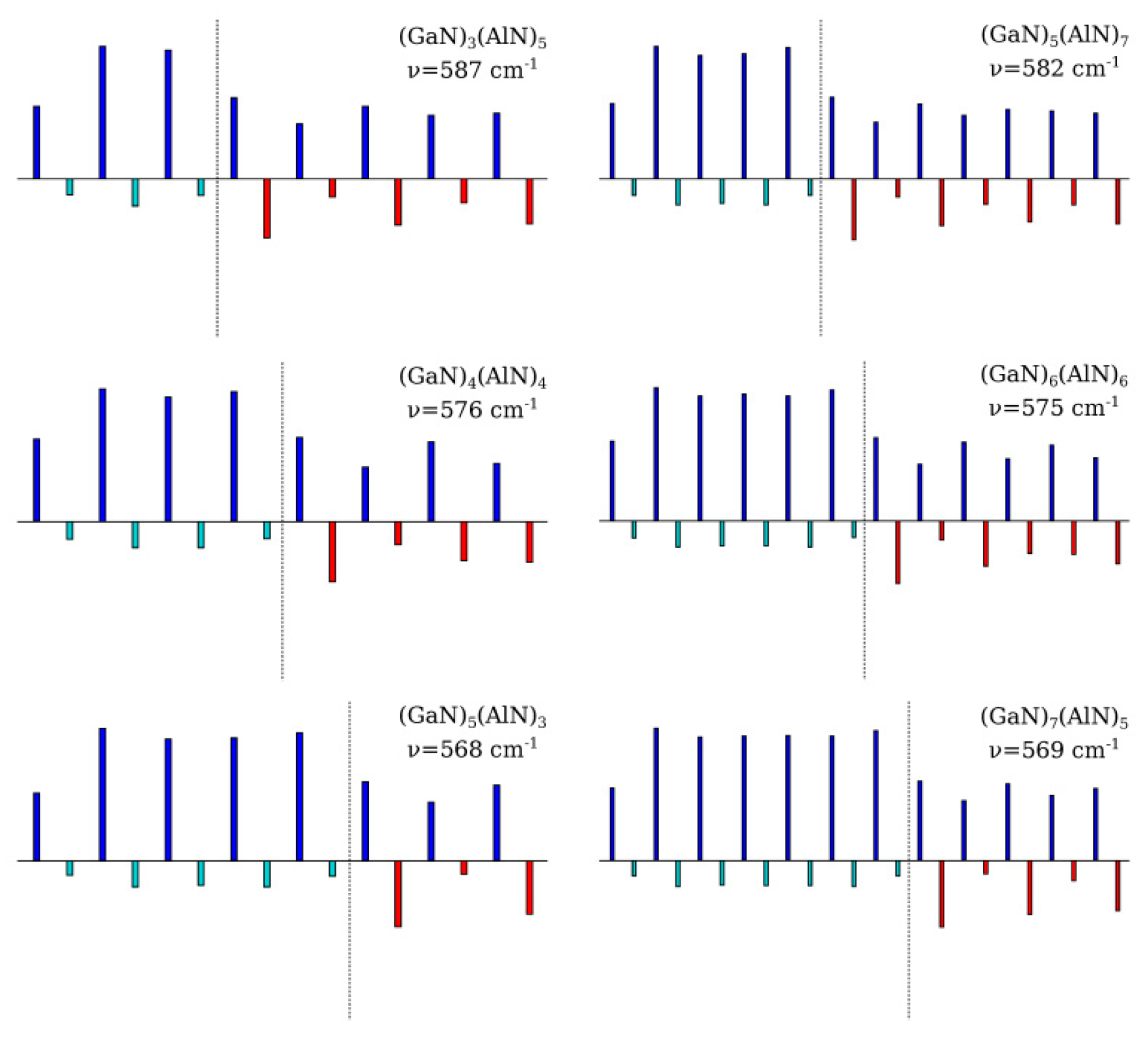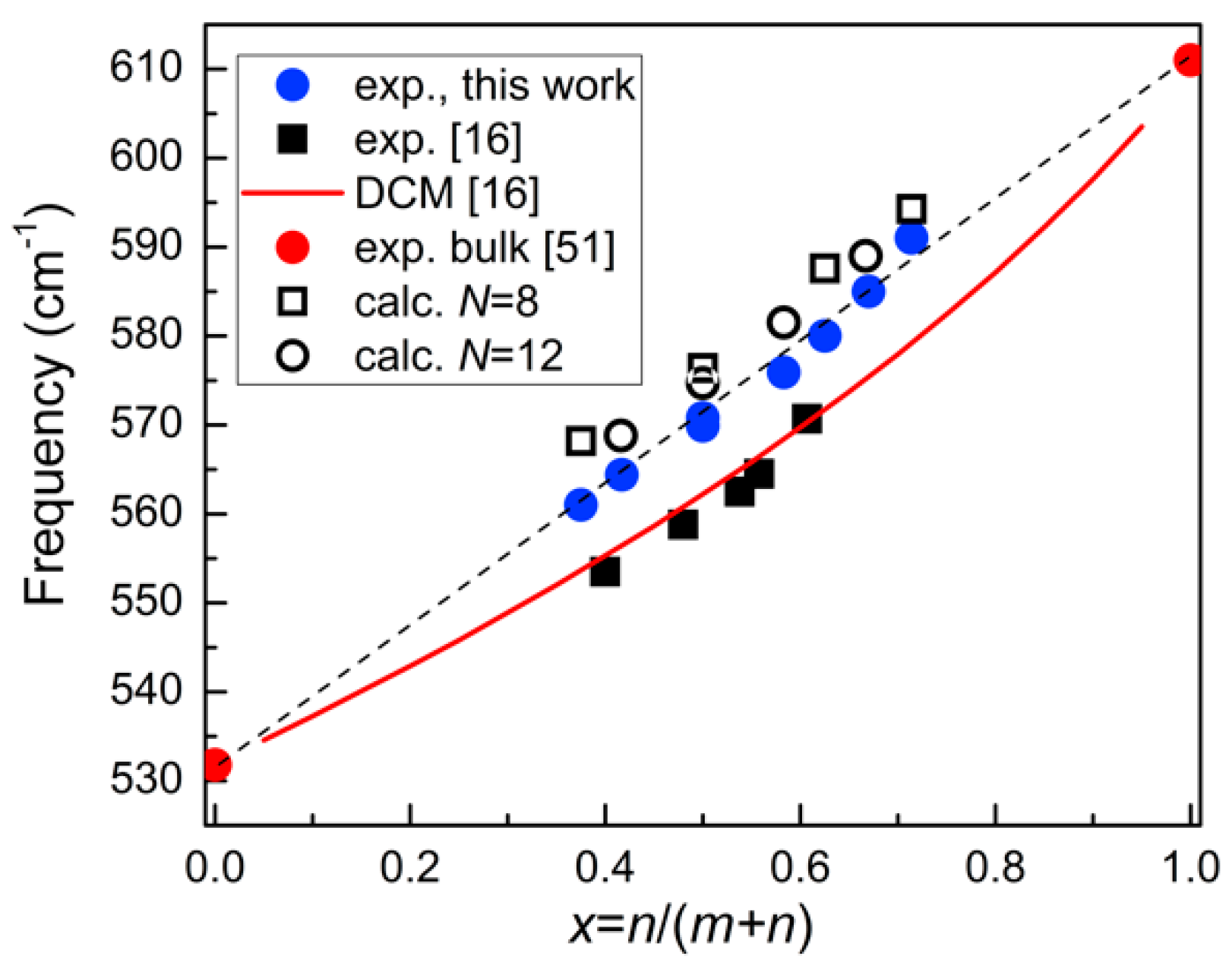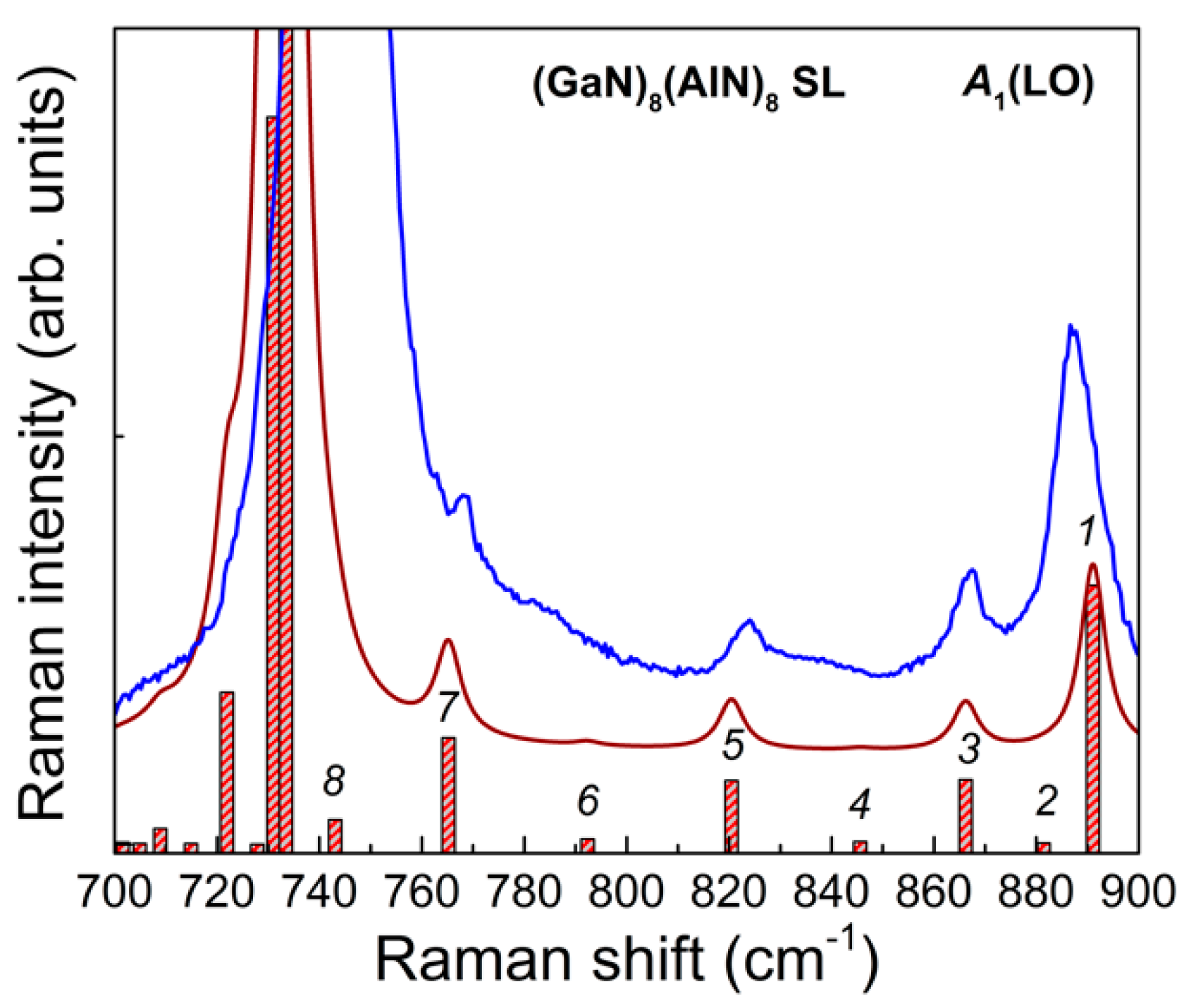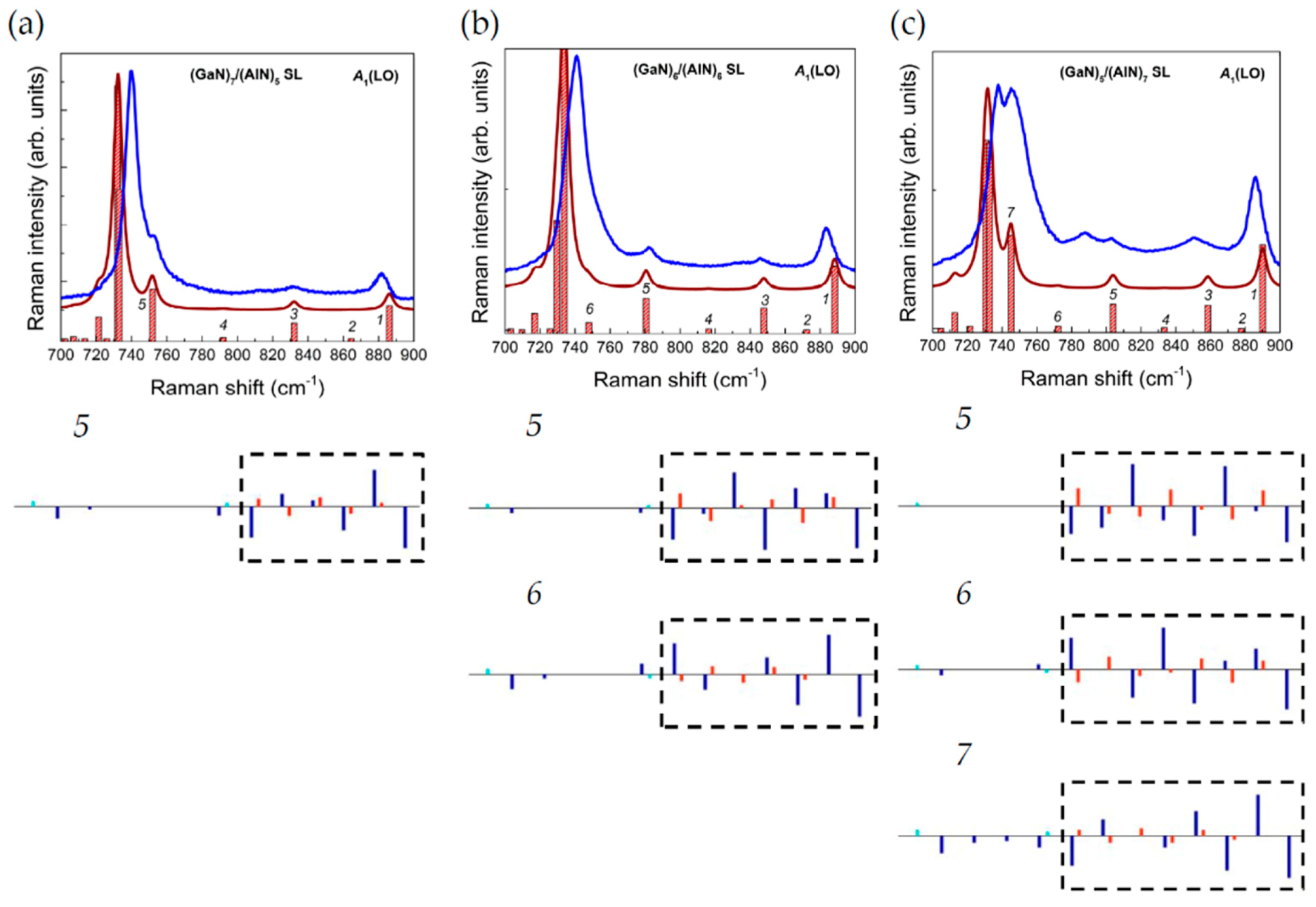3.1. Growth
To understand the growth of GaN/AlN SLs under metal-rich conditions using submonolayer digital PA MBE, we analyzed the desorption kinetics of both Al and Ga atoms using desorption rates equal to zero for the former and 0.22 ML/s for the latter at a substrate temperature of 690 °C, as it has been determined in [
17]. The Al-rich conditions used for the growth of AlN layers to precisely control their thickness using a calibrated flux of N
2* led to the accumulation of Al adatoms due to the lack of their desorption. However, even in the case of the thickest AlN layers in (GaN)
8/(AlN)
8 SL, the amount of Al adatoms accumulated during the growth of one AlN layer in the SL did not exceed 0.2 ML. Therefore, although after the completion of AlN growth and switching of the Al/Ga shutters, these excess adatoms are incorporated in the AlN layer instead of the nominal GaN layer due to the higher binding energy for the AlN compound as compared to GaN, the effect of expansion of the AlN layer relative to its nominal thickness can be neglected.
It should also be noted that a small excess of Al flux did not ensure the formation of an Al-bilayer on the AlN surface, which, as is known, leads to two-dimensional (2D) growth of AlN layers using PA MBE [
25]. Meanwhile, RHEED exhibited a continuous streaky pattern throughout SL growth (
Figure S1a), indicating its constant 2D-surface morphology. This fact can be explained by the surfactant effect of Ga adatoms occurring on the SL surface not only during the growth of GaN layers, but also during the subsequent growth of AlN layers. Indeed, the surfactant effect, resulting in the surface smoothing due to an increase in the surface mobility of adatoms, was widely observed for the PA MBE of bulk AlN layers and GaN/AlN multiple QW structures with the addition of non-incorporated Ga adatoms [
26,
27].
The strongly Ga-enriched growth conditions of the GaN layers led to the very rapid (<2 s) formation of a Ga-bilayer on the surface of these layers, and then excess Ga adatoms accumulated in small nanoclusters, as usually happens in the conventional metal-modulated epitaxy of binary III-Nitrides [
17,
28,
29]. It can be assumed that the Ga nanoclusters, due to the low Ga-desorption rate
~0.2 ML/s, supply sufficient Ga adatoms to form a Ga-bilayer on the surface of Al layers throughout their entire growth. A detailed analysis of excess Ga adatoms will be reported elsewhere. Here, the excess of Ga atoms accumulated during the growth of one GaN layer for a time of
was approximately estimated from the difference in fluxes
. Then we estimated the time required for the complete evaporation of this volume of Ga atoms at the same desorption rate. A greater or equal value of this time found for all SLs compared to the growth time of the AlN layer indicated a sufficient amount of Ga atoms for continuous coverage of the AlN layer surface with a Ga-bilayer.
The above estimates were experimentally confirmed by in situ optical observation of the Ga adlayers on the surface of SLs. For this purpose, we used the effect of decreasing the readouts of the IR-pyrometer by several degrees (~5–7 °C) when a Ga-bilayer appears on the surface, as it has been described by us in [
17].
Figure 1a shows the temporal evolution of the IR-pyrometer readouts during the growth of 42 × 6 × {(GaN)
8/(AlN)
8} SL with periodic (
K = 42;
L = 6) 60-s anneals at a constant power of the substrate heater and closed shutters of all effusion cells and the N
2*-source. However, at the beginning of each 6 × SL-period growth at time zero in
Figure 1a, the readout of IR-pyrometer increases due to radiation heating of the substrate from the open Ga-cell, then it drops sharply to a level below the initial set value of 690 °C. Most likely, this can be associated with the appearance of a Ga bilayer on the GaN surface. In addition, after GaN/AlN switching, a decrease in the temperature can be associated with weaker radiant heating from the Al-cell [
17]. A lower level of the readouts persists throughout the growth of both the GaN and AlN layers over six SL periods, and the observed small oscillations (~2 °C) can apparently be explained by different fluxes of thermal radiation from Ga and Al cells, which lead to a small change in the substrate surface temperature. It should be emphasized that during annealing after the growth of six SL periods, the pyrometer readout further falls to a minimum level of about 6 °C below the initial set value, which remains constant and then gradually recovers.
Figure 1b shows a similar behavior of the pyrometer readouts during the growth of 44 × 13 × {(GaN)
4/(AlN)
4} SL with 44 anneals for 60 s each after every thirteen SL periods. Almost the same duration of the recovery time for the readout of the substrate temperature after the growth of the SL with approximately the same thickness (~26 nm), at least, does not contradict the qualitative model developed above. Thus, the behavior of the IR-pyrometer readouts most likely indicates the periodic formation of small metallic Ga-nanoclusters during the growth of several SL periods, which ensure the continuous occurrence of a Ga-bilayer on the SL surface. The absence of residual traces from metallic GaN droplets on the SL surface was confirmed by their observation with scanning electron and optical microscopes, as shown in
Figures S1b and S2.
3.2. Group-Theoretical Analysis
Short-period wurtzite (GaN)
m/(AlN)
n superlattices (SL’s), though keeping the properties of parent GaN and AlN crystals, are, in fact, new crystals with space groups and atomic arrangements over the Wyckoff positions, which depend on the numbers
m and
n of GaN and AlN monolayers per SL primitive unit cell. As was established in our earlier paper [
30], short-period (GaN)
m/(AlN)
n SLs grown along the hexagonal symmetry axis constitute two distinct crystal families specified by space groups
P3m1 (# 156) and
P63mc (# 186) depending on whether
m +
n is even or odd, respectively.
In this paper, we have determined the symmetry of phonons in bulk crystals and in the SL family with even m + n and derived the first-order Raman selection rules. We have also established the genesis of SL phonon modes from those of the bulk.
The phonon symmetry in bulk crystals and in the
P3m1 (# 156) SL family is presented in
Table 1 and
Table 2, respectively. The phonon symmetries at the symmetry points of the Brillouin zone (BZ) are obtained by the method of site-symmetry induced representations using the SITESYM program [
31] of the Bilbao Crystallographic Server (BCS) [
32,
33,
34]. A detailed description of this method can be found in [
35].
The structure of
Table 1 and
Table 2 is the following. Column 1 contains the atomic arrangements over the Wyckoff positions
q, given in column 2, together with their coordinates in units of basic translations (
a1,
a2,
a3) of the crystallographic unit cell and site symmetry groups G
q. Column 3 gives irreducible representations (irreps) β of G
q according to which the local atomic displacements
x,
y,
z transform. The rest of the columns lists the labels of the little-group irreps induced by the irreps β of G
q. These induced representations determine the symmetries of normal vibrations at the high-symmetry points of the BZ of
P3m1. The
k-points are specified by their labels, primitive coordinates, and little co-groups G
k (for more details see Brillouin-zone database on the Bilbao Crystallographic Server [
32,
33,
34]). The notation for space-group irreps follows [
36], while that of point-group irreps follows [
37]. The description of the space groups and their Wyckoff positions are chosen in correspondence with [
38].
From
Table 1 and
Table 2, one can write down directly the sets of normal phonon modes at any symmetry point of the BZ summarizing the contributions of all the atoms in the primitive unit cell. Those at the symmetry lines can be easily obtained from the compatibility relations.
Each line in
Table 1 and
Table 2 corresponds to a band representation. All band representations can be also obtained using the program BAND REPRESENTATIONS of the BCS [
39,
40].
For example, for GaN (AlN) bulk crystals where all atoms occupy 2b positions, there are two phonon bands (see
Table 1).
The local
z-displacements transforming according to a
1(
z) induce the following band along the Г–A direction
whereas local
x,
y-displacements transforming according to e(
x,
y) induce the band
Note that the A1⊕A4 and irreps form pairs of complex-conjugated irreps, which correspond to degenerated states with the same energy at the BZ boundary.
For the first-order Raman scattering, the sets of normal modes at the Г-point are of importance. Summarizing the contributions of all the atoms in the primitive cell, we obtain the mechanical representation at the Г-point
where Г
ac = Г
1(
A1) + Г
6 (
E1). Notations of irreps in parentheses follow [
37].
The simplest (GaN)1/(AlN)1 SL is obtained from the bulk GaN crystal by substituting one Ga atom in the primitive unit cell of the wurtzite lattice by the Al one. As a result, two metal atoms in the unit cell, which were connected by symmetry operation, become non-equivalent, and the P63mc symmetry of the bulk crystal becomes P3m1, whereas the primitive unit cell does not change. In this SL, there are four atoms per primitive cell (Ga, Al, and 2 N).
From
Table 2, we write the mechanical representation at the Г point
where Г
ac = Г
1(
A1) + Г
3(
E).
The Raman selection rules can be obtained using the POLARIZATION SELECTION RULES program [
32,
33,
34] at the BCS. The results are shown in
Table 3 and
Table 4.
Comparing sets of normal modes for the bulk crystal and the (GaN)
1/(AlN)
1 SL, we see that the number of Raman active modes being four in bulk GaN (without taking into account LO-TO splitting) becomes six in the (GaN)
1/(AlN)
1 SL with
P3m1 symmetry. It should be noted that for this simplest case of SLs, the primitive unit cell of the SL does not increase with respect to the bulk. Therefore, only point symmetry of the SL decreases, which results in the lifting of the degeneracy of complex-conjugated states at the BZ boundary. The symmetry correspondence between the phonon states of the bulk GaN (AlN) crystal (left side of relations) and that of the (GaN)
1/(AlN)
1 SL (right side of relations) at the Г and A points of the BZ has been obtained using the CORREL program of the BCS [
32]
It is seen that Г1(A1) and Г4(B1) modes of bulk GaN transform into Г1(A1) modes of the (GaN)1/(AlN)1 SL and become non-distinguishable from the point of view of selection rules. In particular, two silent Г4(B1) modes become Raman-active. In turn, Г5(E2) and Г6(E1) modes transform into Г3(E) ones. Thus, from Equation (3), we see that the phonon modes of the bulk constitute pairs with components transforming into phonon modes of the same symmetry in (GaN)1/(AlN)1 SL.
For other SLs with the P3m1 (# 156) symmetry, the corresponding primitive unit cells enlarge, which results in the folding of phonon states at the A-point of the BZ. Thus, the A-point of the BZ turns to be very crucial for the SL phonon genesis.
Using the CORREL program of the BCS [
32] with a corresponding unit cell transformation matrix one obtains that the A-point states of the bulk crystals (A
1⊕A
4 and A
5⊕A
6) transform into the SL states at the Г point as follows: two Г
1 (
A1) (A
1 → Г
1, A
4 → Г
1) states with close frequencies and two Г
3 (
E) (A
5 → Г
3, A
6 → Г
3 ) states also with close frequencies.
The SL modes originated from bulk acoustic branches Г1–A1 (LA), Г6–A6 (TA) are located in the low and mid-frequency range, whereas those originated from the bulk optical modes lie in the high-frequency range.
The results of the group-theoretical analysis will be used below when discussing the results of the ab initio calculations and experiments.
3.3. Raman Measurements
3.3.1. Low Energy Phonon Modes
The low energy phonon states in GaN/AlN SLs are closely related to acoustic modes of the bulk materials. The existence of interfaces does not cancel the propagating character of such modes, but changes the sound velocity and gives rise to stationary modes, which are related to the folded acoustic waves. The group-theory analysis of the phonon symmetry in wurtzite-based (GaN)m/(AlN)n SLs allows concluding that the folded LA phonons have A1 and E symmetry and can be observed in the scattering geometry, and the folded TA phonons have E symmetry and can be observed in the scattering geometry.
Indeed, in the low-frequency spectral range (0–300 cm
−1), the SL normal modes are originated from the GaN and AlN bulk acoustic Г
1–A
1 (LA), Г
6–A
6 (TA) and optical Г
4–A
4 (silent), Г
5–A
5 phonon branches. As shown above (see
Section 3.2), the bulk states A
1⊕A
4 and A
5⊕A
6 at the BZ boundary correspond to two degenerate phonon states each one combined from one acoustic and one optical phonon branch. In the SLs with even
m +
n, this degeneracy is lifted, and the degenerate states when folded transform into two different Г
1 (
A1) states with close frequencies and two Г
3 (
E) states also with close frequencies. Note that in the SL space group, the irreps for all points along the whole Δ-line (Г–Δ–A), including Г and A points, are of the same type, since the group is polar with the polar axis along
z.
The calculated and experimental low-frequency parts of the
Raman spectra for 4/4, 6/6, and 8/8 SLs are compared in
Figure 2.
One can see that the experimental and calculated
Raman spectra agree well. This allows one to establish an unambiguous assignment for the observed spectral features. Both spectra contain the doublet-like spectral feature, which exhibits a high-frequency shift while decreasing SL’s period. Additionally, there is another middle-intensity peak that does not move with varying the SL period. An analysis of the calculated eigenvectors allowed us to assign the doublet feature to the folded LA phonons and the middle-intensity Raman peak to the
E2-mode localized within the GaN layers. Eigenvectors of the LA-modes giving rise to the doublet-like Raman feature are displayed in
Figure 3.
The most intense peak is related to the LA1 mode.
Figure 3a evidences that in this mode, the largest displacement amplitudes correspond to atoms located at the interfaces, and the nodal planes are located in the middle parts of the layers. Such a vibration corresponds to the alternating stress–strain oscillations of the layers: within the SL half-period, the GaN layers expand and AlN layers compress, and vice versa. Anytime, the neighboring layers undergo the
U3 homogeneous deformations of opposite signs. The frequency of such oscillation changes significantly with a change of the SL period because of the difference in the
C33 elastic stiffnesses of the GaN and AlN materials. Relatively high Raman activity of the LA1 mode can be explained by the difference in the
p13 opto-acoustic constants of the GaN and AlN materials. The total value of the derivative
is proportional to the difference
. According to [
41], the values of elasto-optical constants
p13 for GaN and AlN crystals differ by about 10%. This difference is sufficient for the LA1 mode to have significant activity in the Raman spectrum in the
scattering geometry.
Close to the LA1 mode line is the line of the LA2 mode. According to the atomic displacement patterns shown in
Figure 3b, this is also the LA-mode with a wavelength equal to the SL period. However, the displacement pattern of this mode is different: the largest amplitudes correspond to the atoms located in the middle of the layers, while the atoms located at the interfaces do not vibrate. For this mode, one half of each layer is compressed, and the other half is stretched. The changes of polarizability caused by the elasto-optical effects in the two halves of every layer have different signs for the LA2 mode. Therefore, they almost cancel each other. As a result, this mode has low Raman activity.
The group-theory analysis of the phonon symmetry of the wurtzite-based (GaN)
m/(AlN)
n SLs with even
m +
n suggests that the
E symmetry modes are active in the Raman spectra in the
scattering geometry (see
Section 3.2).
Figure 4 shows the low-frequency parts of the calculated and experimental Raman spectra corresponding to the
scattering geometry. As was mentioned above, lines corresponding to the TA phonons should be observed in this case.
It can be seen that in calculations and experiments, the line positions noticeably change depending on the SL period. The proximity of the positions of these peaks in the calculations and experiment and the similarity of their dependence on the structure allows us to suggest that the lines in the calculated and observed spectra correspond to the same phonons. To understand the nature of these modes, we turn to the analysis of the calculated eigenvectors. According to the calculation, the lowest frequency line in the spectrum is related to the TA modes with a wavelength equal to the SL period. The second spectral line at around 30 cm−1 higher (labeled as 2TA) corresponds to the TA acoustic wave with a twice shorter wavelength.
As it was noted in [
42], the frequency position of the TA and 2TA lines carries information that allows one to determine the period of the SL. In the elastic continuum approximation, the frequencies of the acoustic TA and 2TA phonons are determined by the relations:
where
VSL is the speed of sound in the SL and
d is the period of the SL.
Our computational and experimental results confirm the validity of Equation (4) with
VSL = 4.66 km/s. This value agrees well with the equation
, which relates the sound velocity in the SL with the velocities in GaN and AlN crystals [
43,
44].
3.3.2. E(TO) Phonons
Already in early works devoted to the study of phonons in SLs [
16,
42], it was established that for polar phonons with a wave vector perpendicular to the interface plane, the dipole–dipole interaction between the vibrations of atoms of neighboring layers is completely screened by surface charges at the interfaces. Therefore, in SLs made of materials with strongly differing phonon frequencies, such modes have the character of vibrations localized in separate layers. Nonpolar modes are also localized if their frequencies in one material do not overlap with the frequencies of similar modes in the materials of adjacent layers. In the case of binary GaN/AlN SLs, the first type includes modes that correspond to polar
E1(TO) vibrations in bulk GaN and AlN wurtzite crystals, and the second one—to nonpolar vibrations of the
E2 type. The
E2–E1 frequency intervals in GaN and AlN do not overlap. Therefore, the corresponding SL modes have the character of stacked standing waves localized in separate layers.
Although in nitride SLs the GaN and AlN layers retain the packing symmetry of the wurtzite structure, due to the disappearance of the sixth order screw axis, the modes of the
E1 and
E2 irreps transform into the modes with the same symmetry described by the
E irrep (see
Section 3.2). In the Raman spectra of the
geometry, modes of this type give groups of lines in the
E2–E1 frequency ranges of GaN and AlN. The number of lines in each such group should correspond to the number of monolayers in the GaN and AlN layers. Note that in both materials, the frequency intervals
E2–
E1 are relatively narrow (~10 cm
−1). Therefore, in an experiment, we are unlikely to be able to distinguish between individual lines and determine their number. Rather, these lines will merge into an asymmetric band ~20–30 cm
−1 wide. The asymmetry of this band is a consequence of the different Raman intensities of the
E1 and
E2 modes. In both materials, the
E2 modes show noticeably higher Raman activity. Taking into account that the ω(
E1) < ω(
E2) ratio is observed in GaN and in AlN the opposite ω(
E2) < ω(
E1) holds, we can expect that the maximum in the
E(GaN) band contour will be closer to the high-frequency edge, and in the
E(AlN) band contour, on the contrary, the maximum will be closer to the low-frequency edge.
It is these bands that we observe in the spectra of the studied SLs.
Figure 5 shows the
geometry Raman spectra of (GaN)
m/(AlN)
n (
m,
n = 4,6,8) SLs in the frequency range of
E(TO) oscillations.
Both in the experiment and the calculation, two asymmetric bands are clearly distinguishable in each spectrum, which correspond to the
E(TO) vibrations localized in the GaN and AlN layers. This assignment can be confirmed by analyzing the corresponding eigenvectors. Consider, for example, the spectrum of the (GaN)
6/(AlN)
6 SL. In
Figure 6, the experimental spectrum of the
geometry is compared with the calculated one.
It can be seen that six modes contribute to the profile of every band: modes 1–6 to the
E(TO)-GaN band and modes 7–12 to the
E(TO)-AlN band. The eigenvectors of the extreme ones are shown in
Figure 7.
The presented displacement patterns show that modes 1 and 6 (like the rest 2–5) correspond to E(TO) vibrations localized in the GaN layer, and modes 7 and 12 (like the other 8–11) correspond to E(TO) vibrations localized in the AlN layer. Moreover, modes 1 and 12 are similar to the E1(TO) modes in bulk crystals: all cations move in phase in the direction opposite to the movement of the anions. In turn, modes 6 and 7 are similar to the E2 modes in bulk crystals: neighboring cations (like anions) move in opposite directions. This analysis confirms our assignment of the E(TO) line edges to the E1 and E2 modes.
The appearance of doublets in the Raman spectra in the frequency range of E(TO) phonons can be also explained based on the results of the group-theoretical analysis.
The SL
E(TO) modes originate from the pair of bulk phonon branches:
which stick together at the A-point of the BZ, i.e., they form a pair of complex-conjugated irreps A
5⊕A
6, which correspond to a degenerate phonon state (see
Section 3.2). In SLs, this degeneracy is lifted due to the lowering of space symmetry from
P6
3mc (# 186) to
P3m1 (# 156). As a result, this degenerate state splits at the A-point and then transforms into the Г-states of the SL due to folding: A
5 → Г
3, and A
6 → Г
3. As a result, the small splitting of the degenerate bulk states at the BZ boundary leads to the formation of
E(TO) doublets at the Г-point in SLs. It should be noted that the frequencies of the
E2 and
E1 modes in GaN and AlN are very sensitive to lattice strains. This dependence has become the subject of numerous studies [
45,
46,
47,
48,
49], the result of which has been the determination of the so-called deformation potentials that relate frequency shifts of the Raman lines with the homogeneous strain of the crystals.
The observed shifts of the lines in
Figure 6 relative to their position in bulk unstressed crystals are definitely associated with the strains of the layers that arise during the growth of the heterostructure. In particular, the line shifts corresponding to the localized
E(TO) vibrations in the AlN and GaN layers have different signs that indicate different signs of strains in these layers. In
Table 5, the in-plane strain values in the SL layers are summarized, which were obtained using the data on the phonon deformation potentials for GaN [
46] and AlN [
49].
The obtained estimations of the elastic strains are based on the deformation potentials derived from investigations of rather thick epitaxial layers or bulk crystals. Whether they apply to the short-period SLs, the answer to this question will be given after additional experimental studies of the structural characteristics of the SLs samples. This issue is under study.
3.3.3. A1(TO) Phonons
As was established earlier [
16], the polar phonons with a wave vector directed within the interface plane have a delocalized character. Due to the dipole–dipole interaction, atoms of all layers are involved in such vibrations. Consequently, the frequency value depends on the ratio of the layer thicknesses, varying in the range of values corresponding to bulk materials. This circumstance makes such modes a convenient tool for monitoring the composition of SLs.
In the spectra of binary nitride SLs, the polar delocalized modes include
A1(TO) and
E1(LO) symmetry modes. The
A1(TO) modes are the most favorable for controlling the composition, since they give intense lines in the Raman spectra in the
scattering geometry, which are convenient for observation. Examples of such spectra of the samples studied in this work are shown in
Figure 8.
It can be seen that the calculation quite accurately reproduces the experimentally observed spectral curves with a slight systematic overestimation of the frequency magnitude by about 5 cm
−1. The calculation also confirms the delocalized nature of these modes (see
Figure 9). Analysis of the calculated eigenvectors of these modes allows us to understand the nature of their high intensity in the spectra. The pattern of atomic displacements is similar to that of the TO modes in pure crystals, and the amplitudes of both cations and anions in all layers are approximately the same.
As was predicted in early papers [
16,
50], the frequency of
A1(TO) modes in SLs should strongly depend on the ratio of the layer thicknesses. The analysis of the spectra of the samples studied in this work revealed that the dependence of the frequency on the composition parameter
) turned out to be close to linear (see
Figure 10). This result differs from that obtained in our previous works [
16] based on the study of SLs grown by MOVPE. The
A1(TO) mode frequencies for those samples (also shown in
Figure 10) are in a good agreement with the ω(
x) dependence established for solid solutions [
51] and predicted by the dielectric continuum model [
16].
It should be noted that the ω(x) dependence, based on the results of non-empirical calculations, also has a rather non-linear character. Moreover, as the total number of layers in the SL period increases, the calculated ω(x) dependence progressively approaches the experimental one.
The difference in the dependences established in this case for two types of SLs can be explained by the difference in the quality of the samples grown by different methods. According to structural studies, the samples studied in this work have well-localized interfaces. That is why the ω(x) dependence determined for them is in good agreement with the results of calculations, in which the interfaces were assumed to be abrupt.
3.3.4. A1(LO) Phonons
As well as the
E(TO) modes considered above, the polar modes with symmetry
A1(LO) have the character of vibrations localized in separate layers of GaN/AlN SLs. The bands in Raman spectra that correspond to these vibrational modes should be observed in the spectra obtained in the
scattering geometry in the ranges 690–733 (GaN-like) and 719–875 (AlN-like) cm
−1, since the frequency ranges of these modes for bulk GaN and AlN crystals slightly overlap. The calculated and experimental high-frequency Raman spectra for the
scattering geometry, obtained for some of the studied SLs, are shown in
Figure 11. It can be seen that there is a good agreement between the calculated and experimental spectra. This allows us to make an unambiguous assignment of the observed spectral features. For localized phonons, the frequency values ω and the number of such modes should depend on the individual characteristics of the layers comprising the SL. The latter circumstance makes such modes a convenient tool for monitoring the SL structure. Let us show that the number of
A1(LO) symmetry modes depends on the thickness of the SL layers. For this, we consider in more detail the spectrum in the
geometry for the (GaN)
8/(AlN)
8 SL shown in
Figure 12.
In the range of 740–890 cm
−1, there are eight modes in the spectrum, half of which give a noticeable contribution in the Raman spectrum. The atomic displacements in the corresponding modes are shown in
Figure 13. It can be seen that (a) the atoms in the AlN layers are mainly involved in these vibrations; (b) these vibrations really correspond to the shape of
A1(LO) modes (cations and anions are shifting along the
z-axis in opposite directions); (c) the amplitude distribution (at least for the first five modes) resembles the harmonics of standing waves with nodes at the interfaces.
The latter circumstance explains the fact that only half of these modes have the Raman scattering intensity noticeably different from zero. These are odd-numbered modes (
Figure 13, 1,3,5,7), which correspond to harmonics with a non-integer number of periods in the layer. In the experimental Raman spectrum (shown by the blue line in
Figure 11), the four well-pronounced bands, which correspond to the above-mentioned vibrations, can be distinguished, although the line of mode 7 overlaps strongly with the wide band of the
A1(LO) GaN mode. Thus, we conclude that the presence of
N lines in the
spectrum in the 740–890 cm
−1 range indicates that the AlN layers under study contain 2
N monolayers. This conclusion is also confirmed by the spectra of other SLs studied shown in
Figure 11: there are two bands corresponding to the
A1(LO)-AlN modes in the Raman spectra of 4/4 SL, and three bands in the spectrum of 6/6 SL.
In
Figure 12, one can also see the presence of eight modes in the range of 700–740 cm
−1. These are
A1(LO) modes localized in GaN layers. Due to the narrowness of this frequency interval, it is not possible to distinguish between the corresponding lines (or even determine their number) in the experimental spectrum. In the experiment, all these bands merge into one strong asymmetric peak with a maximum close to
A1(LO)-GaN. An analysis of the eigenvectors of the
A1(LO) modes localized in the GaN layers showed that they all noticeably mixed with the
B1 mode of the AlN layer and therefore, strictly speaking, are not localized.
A question arises: what does the Raman spectrum of the
A1(LO)-mode look like for an odd number? Let us consider this issue on the example of (GaN)
m/(AlN)
12-m SL.
Figure 14a–c shows the calculated and experimental spectra in the
geometry in the range of
A1(LO) modes of three SLs: 7/5, 6/6, and 5/7. The bars show individual modes and represent the Raman intensity. On the whole, we can state a good agreement between the calculation and experiment, both in the number of peaks and in their position and relative intensity. It can also be seen that in the 740–900 cm
−1 range, the 7/5, 6/6, and 5/7 SL spectra contain contributions from five, six, and seven modes, respectively. This is consistent with the number of standing wave harmonics localized in the AlN layers. However, as noted above, only three out of six modes make a noticeable contribution to the spectrum of the 6/6 equal-period SL. In the 7/5 SL, there are three of five such modes, and in the 5/7 SL, there are four of seven such modes. Moreover, the last odd harmonics (the fifth in 7/5 SL and the seventh in the 5/7 SL) have a high Raman intensity comparable to the intensity of the first harmonic. This effect can be explained by analyzing the eigenvectors of these modes. Both of them noticeably mix with atomic vibrations in the GaN layers, and these admixed vibrations are symmetric with respect to the middle of the GaN layer.
Based on the results of the group-theoretical analysis, we can establish the hierarchy of
A1(LO) mode intensities in Raman spectra. Similarly, like E-branches, the
A1(LO) modes in SL’s originate from the pair of bulk phonon branches:
These branches also stick together at the A-point of the BZ, i.e., they form a pair of complex-conjugated irreps A
1⊕A
4, which correspond to a degenerate phonon state (see
Section 3.2). In SLs, due to the lowering of space symmetry, this degenerate state at the A-point splits and then, due to folding, transforms into the Г-states of the SL: A
1 → Г
1 [
A1(LO)], A
4 → Г
1 [
A1(LO)]. In turn, the Г
4 [
B1] state also transforms into the Г
1 [
A1(LO)] mode. Thus, among the Г
1 [
A1(LO)] modes in the SL, there are strong modes originated from the bulk Г
1–A
1 (
A1(LO)-branch) and relatively weak modes originated from the bulk Г
4–A
4 (
B1 -silent branch).
Thus, we can extend the scheme for interpreting the geometry spectra of short-period (GaN)m/(AlN)n SLs in the A1(LO) frequency range to the case of odd n. The following rules can be suggested:
If the line with the lowest frequency in the 740–900 cm−1 interval has relatively low intensity (less than the intensity of the first line) and does not overlap with the A1(LO)-GaN line, then in the studied SL, the number n is even and is twice the number of lines observed in this spectrum.
If this last line has a high intensity (comparable to that of the first line) and is close in frequency to the A1(LO)-GaN line (which manifests itself as a doublet splitting of this line), then in the SL under study, the number n is odd and equal to 2k + 1, where k is the number of lines observed in this spectrum.
The results presented in this Section can be summarized as follows. The established close-to-linear dependence of the A1(TO) frequency on the concentration parameter together with the data on the SL period derived from the frequency of the folded acoustic LA1 phonon can be used to quantify the thicknesses of the GaN and AlN layers. Additional verification of the estimated thickness of the AlN layer is a determination of the number of monolayers, which is based on an analysis of A1(LO) Raman peaks in the LO(AlN) spectral region. The latter method was first proposed in this work.
The experimental Raman spectra for the 4/4, 6/6, and 8/8 SLs are shown in
Figure S3 in order to demonstrate the changes in the intensities and positions of the acoustic and optical modes in dependence of the SL period.

